
Dimdima
Online Children's Magazine from India

Dimdima
Online Children's Magazine from India

Legend has it that once when Parasurama was seeking a place to meditate, he decided to shoot an arrow and go wherever it fell. The arrow fell into the Arabian Sea. The waters parted, creating an idyllic land - Goa.
Archaeological finds have showm that Gowapur, as Goa was called earlier, was an important port, strategically located on an Arab trade route even in the 3rd century B. C. It was ruled by a series of Hindu dynasties until the 15th century, when it fell into the hands of Adil Shah, the founder of the Adilshahi 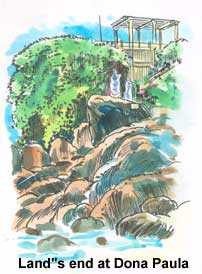 dynasty of Bijapur. The Portuguese acquired it in 1510 and ruled for 451 years, till 1961. when Goa became a part of India.
dynasty of Bijapur. The Portuguese acquired it in 1510 and ruled for 451 years, till 1961. when Goa became a part of India.
Goa has a 105-kilometre-long coastline. From Terekhol in the north to Polem in the south one can see miles of white sands, separated by rocky headlands and estuaries. The Portuguese built a fort on each of these headlands to guard the approach from the sea and the route up the rivers to the inland settlements.
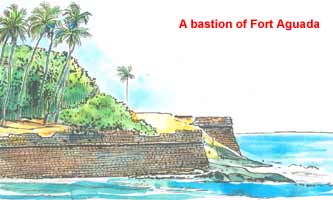
The most impressive of these forts,is Aguada (from Agua, water) named after the number of fresh water springs inside. These were the main source of drinking water for ships that reached the Mandovi estuary after a long journey acrosS the Indian Ocean. The Aguada and the Reis Magos forts serve as prisons now, just as they did during the Portuguese rule.
 In between the forts lie the golden beaches, for which Goa is famous.
In between the forts lie the golden beaches, for which Goa is famous.
Harmal, Chapora, Vagator, Anjuna, Baga, Calangute, Gaspar Dias and Dona Paula are the better known beaches of north Goa. The arch-shaped Calangute beach, called the 'queen of beaches', attracts the maximum number of tourists. The Dona Paula beach, to the south, is named after a viceroy's daughter, who threw herself off a cliff here, when refused permission to marry a local fisherman.
On top of a cliff at the Baga beach, to the north of Calangute, is a serene white chapel known as the Retreat House. The path leading up to the chapel has picturesque scenes depicting the 'Way of the Cross'.
Velha Goa or Old Goa about nine kilometres up river from Panaji was the capital of Goa in the 16th century. It rivalled Lisbon in grandeur in those days.
On the jetty stands the Viceroy's Arch, which was a symbolic gateway to Goa. Each viceroy had to pass through this arch before he took office. It was built as a memorial to Vasco da Gama who discovered the sea route from Europe to India.
Beyond the arch is the Church of St. Cajetan which resembles St.Peter's Basilica in Rome.
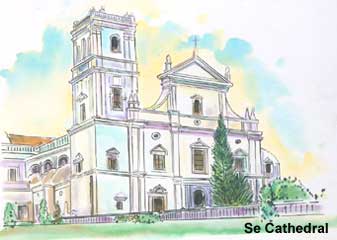
Opposite St. Cajetan is the Se Cathedra!. one of the oldest churches and the largest in Asia. The cathedral houses the legendary "Sino do Ouro" or the "Golden Bell", famous for its mellow tone.
A little beyond is Bom Jesus Basilica also called the Church of St. Francis Xavier. It is the most important church in Goa as it houses the body of 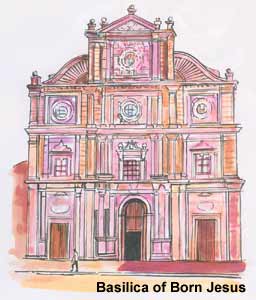 St.Francis Xavier, Goa's patron saint.
St.Francis Xavier, Goa's patron saint.
Francis Xavier was born in April 1506, in Navarre in Spain. While studying in college, he was so deeply influenced by fellow student, lgnatius Loyola, that he dedicated himself to the service of the Lord. He came to Goa on May 6th, 1542, where he preached the Christian faith in simple Portuguese and Konkani. He stayed only tor a few months in Goa. for his 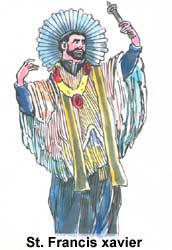 work took him to the Coromandel coast, Sri Lanka, MalacCa, the Moluccas, Japan and finally to China, where he died on the island of Sanchian on December 3rd, 1552. Two years later, his body was dug up and found to be in perfect condition. It was brought to Goa.
work took him to the Coromandel coast, Sri Lanka, MalacCa, the Moluccas, Japan and finally to China, where he died on the island of Sanchian on December 3rd, 1552. Two years later, his body was dug up and found to be in perfect condition. It was brought to Goa.
Every ten years the body, which remains uncorrupted, but has shrunk considerably, is taken in a ceremonial procession from Bom Jesus to the Se Cathedral, watched by lakhs of devotees who come from all over the world to pay their respects to the saint. On the hill opposite Bom Jesus is the Church and Convent of St. Monica, the oldest and  largest nunnery in Eastern Asia.
largest nunnery in Eastern Asia.
Panaji. the capital of Goa is situated on the southem bank of the Mandovi river.
To the left of the Old Secretariat. the oldest building in the state and originally the palace of Adil Shah, is the bronze statue of Abbe Faria who is shown healing a woman through hypnosis. Abbe Faria or Father Jose Custodio de Faria to give him his full name, was a 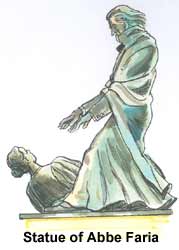 famous Goan priest-scholar-scientist, who left Goa for Portugal in his youth. He was called the 'Father of Mesmerism' and was the first to establish that hypnosis was a science of suggestion. He has been immortalised as the mad monk in the novel 'The Count of Monte Cristo' by Alexandre Dumas.
famous Goan priest-scholar-scientist, who left Goa for Portugal in his youth. He was called the 'Father of Mesmerism' and was the first to establish that hypnosis was a science of suggestion. He has been immortalised as the mad monk in the novel 'The Count of Monte Cristo' by Alexandre Dumas.
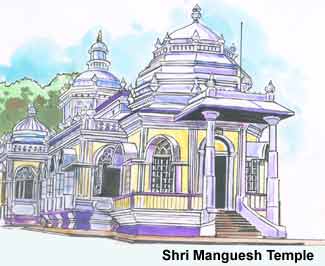
The famous Mangueshi Temple, dedicated to Shiva, is to the southeast of Panaji. According to legend, Parvati came to Goa in search of Shiva, who left Kailasa after a quarrel. As she was walking through the forests, she was confronted by a tiger.
She called out to Shiva to protect her, "Trahi mam Girisha!" (Protect me, Lord of the Mountains!). The original temple stood at this spot and was called Mam Girisha, which eventually became Mangrisha and then Mangueshi.
Last updated on :5/28/2021
Dimdima is the Sanskrit word for ‘drumbeat’. In olden days, victory in battle was heralded by the beat of drums or any important news to be conveyed to the people used to be accompanied with drumbeats.
Bharatiya Vidya Bhavan
K. M Munshi Marg,
Chowpatty, Mumbai - 400 007
email : editor@dimdima.com
Bharatiya Vidya Bhavan
505, Sane Guruji Marg,
Tardeo, Mumbai - 400 034
email : promo@dimdima.com
Dimdima.com, the Children's Website of Bharatiya Vidya Bhavan launched in 2000 and came out with a Printed version of Dimdima Magazine in 2004. At present the Printed Version have more than 35,000 subscribers from India and Abroad.